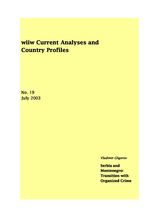Serbia and Montenegro: Transition with Organized Crime
Serbia and Montenegro (S&M) is the Union of these two states that has emerged from the Federal Republic of Yugoslavia. That is only the beginning of the constitutional development that may take some time to be finished. The final outcome is most likely to be two independent states. It is probably the European Union (EU) that is the most interested in the preservation of S&M - partly because it wants to minimize the number of small states as future members and partly because it is not ready to address the issue of Kosovo, which, it is believed, would immediately follow once S&M dissolves. Thus, at the moment, S&M has been given a trial period of about three years to build up a functional state-like union. Chances for success are slim.
The additional reason that S&M has little chance to survive is the pressing need to speed up the process of state- and institution-building. This mainly means the introduction of the rule of law. The urgency of this task has become evident after the assassination of the prime minister of Serbia, Mr. Zoran Djindjic. In its aftermath, it became clear that Serbia is a captured state. This is the inheritance from the Milo¿evic era. However, the post-Milo¿evic governments in Yugoslavia and Serbia chose the strategy of appeasement in many crucial areas, including that of dealing with the organized crime. They apparently believed that the progress of reforms and transition would take care of organized crime. In other words, they seem to have believed that transition with organized crime is possible. In that, they were brutally proved wrong.
The situation in Montenegro is different, though the problems with organized crime are quite serious. It seems, however, that those are dealt with through corruption rather than through partnership. That does not mean that the problems with the introduction of the rule of law are not daunting there, too - especially because of the high level of informal economic activities or, rather, of the dependence of a large number of people on informal activities for their income. This problem is aggravated by the fact that the process of transition has still a long way to go and it will take some time before the country moves to the path of sustainable growth.
Reforms in Serbia and Montenegro have been implemented separately, are at different stages, and are quite possibly incompatible. Montenegro relies, at least in principle, on liberalization, as this is a very small economy and can hardly grow if it is not increasingly opened. Serbia, however, relies on a strategy which sees a significant role for the state. This difference in strategies, though not necessarily in the actual economic situation, has led to probably insurmountable differences in trade policies. Montenegro aims at very low tariff protection, unlike Serbia, which wants to rely on a certain level of protectionism for a longer period of time. This disagreement is the major stumbling block standing in the way of the harmonization of their economic systems, which is a precondition for negotiations with the EU on the Stabilization and Association Agreement.
Both reform strategies have led to a disappointing supply-side response. Serbia has entered into what appears as a transitional recession, at least when it comes to growth of industry, while Montenegro is stagnating at best. In addition, macroeconomic disequilibria - external, fiscal and labour market imbalances - are increasing. Those coincide with the decrease of foreign financial support and investment; and also with the prolongation of the prospects for EU accession despite the promises given at the EU-Western Balkans summit in Thessaloniki held at the end of June 2003.
After the initial strong response by the government to the assassination of the Serbian prime minister Zoran Djindjic, the anti-organized-crime campaign is losing its momentum. With that, political instability is increasing. Some of it is due to the approach
After the initial strong response by the government to the assassination of the Serbian prime minister Zoran Djindjic, the anti-organized-crime campaign is losing its momentum. With that, political instability is increasing. Some of it is due to the approaching elections, with early elections possible in autumn 2003 or regular elections in autumn 2004 at the latest. The recent conflict between the ministry of finance and the central bank in Serbia should be seen in that light. These conflicts are bound to escalate as the elections come closer in time.
The current economic developments are not sustainable, especially in Serbia. Changes in the economic policy can be expected to turn around the negative trends in Serbia. Those are seen as necessary by the governing coalition which wants to stay in power after the elections. Thus, some relaxation of the monetary policy can be expected with the change in the central bank of Serbia. In Montenegro, due to the use of the euro and the need to continue with the fiscal consolidation, there is no room for a policy change and thus for short-term recovery.
The crisis in Serbia cannot be overcome without democratization. That means elections. It is, however, not to be expected that one round of elections will bring speedy improvement. It will probably take another round for political stability to be achieved and economic development to be put on a sustainable path. Similar political developments should be expected in Montenegro too.
Keywords: Serbia and Montenegro, transition, macroeconomic stability, organized crime
JEL classification: P26, P30, P35
Countries covered: Serbia and Montenegro, SEE
Research Areas: Macroeconomic Analysis and Policy
